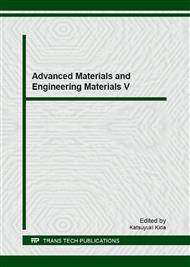p.44
p.49
p.56
p.61
p.65
p.70
p.76
p.81
p.87
The Influence of Graphite Heat Conductor Technology on the Preparation and Crystal Structure of Single Crystal Blade
Abstract:
Graphite heat conductor technology can effectively overcome the mixed crystal defect caused by geometric factors during the forming process of single crystal component. The simulation results show that, As for the component that uses heat conductor technology, the heat elimination condition in the corner of component is improved significantly. Before the melt body generating the supper-cold region at the platform end, the solidification interface will advance into the platform from the blade body with the relatively faster speed. According to the analysis of macro structure, the component with heat conductor, because of the diminution of supper-cold time and supper-cold region, the trend to generate mixed crystal on the platform reduces obviously, on one side near the wall of insulation heater, there is almost no mixed crystal on the platform.
Info:
Periodical:
Pages:
65-69
Citation:
Online since:
August 2016
Authors:
Price:
Сopyright:
© 2016 Trans Tech Publications Ltd. All Rights Reserved
Share:
Citation:


